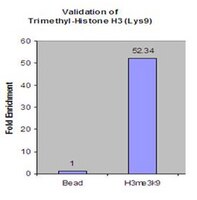05-1242-S Sigma-AldrichAnti-trimethyl-Histone H3 (Lys9) Antibody, clone 6F12-H4, Trial Size
Use Anti-trimethyl-Histone H3 (Lys9) Antibody, clone 6F12-H4 (mouse monoclonal antibody), Trial Size / Pack validated in ChIP, PIA, IF, DB, ChIP-seq, WB to detect trimethyl-Histone H3 (Lys9) also known as H3K9me3, Histone H3 (tri methyl K9).
More>> Use Anti-trimethyl-Histone H3 (Lys9) Antibody, clone 6F12-H4 (mouse monoclonal antibody), Trial Size / Pack validated in ChIP, PIA, IF, DB, ChIP-seq, WB to detect trimethyl-Histone H3 (Lys9) also known as H3K9me3, Histone H3 (tri methyl K9). Less<<Recommended Products
Přehled
| Replacement Information |
|---|
Tabulka spec. kláve
| Species Reactivity | Key Applications | Host | Format | Antibody Type |
|---|---|---|---|---|
| H, M | PIA, IF, DB, ChIP-seq, WB, ChIP | M | Purified | Monoclonal Antibody |
| References |
|---|
| Product Information | |
|---|---|
| Format | Purified |
| Control |
|
| Presentation | Purified antibody supplied at 1 mg/ml in 0.1 M Tris-glycine, pH 7.4, 150 mM NaCl, 0.05% NaN3. |
| Quality Level | MQ100 |
| Physicochemical Information |
|---|
| Dimensions |
|---|
| Materials Information |
|---|
| Toxicological Information |
|---|
| Safety Information according to GHS |
|---|
| Safety Information |
|---|
| Packaging Information | |
|---|---|
| Material Size | 20 µL |
| Transport Information |
|---|
| Supplemental Information |
|---|
| Specifications |
|---|
| Global Trade Item Number | |
|---|---|
| Katalogové číslo | GTIN |
| 05-1242-S | 04053252907463 |
Documentation
Anti-trimethyl-Histone H3 (Lys9) Antibody, clone 6F12-H4, Trial Size MSDS
| Title |
|---|












